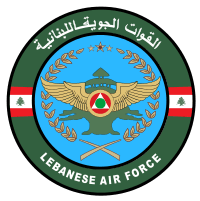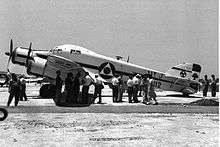Lebanese Air Force
The Lebanese Air Force (LAF) (Arabic: القوات الجوية اللبنانية, Al Quwwat al-Jawwiya al-Lubnaniyya) is the aerial warfare branch of the Lebanese Armed Forces. The seal of the air force is a Roundel with two wings and a Lebanese Cedar tree, surrounded by two laurel leaves on a blue background.
| Lebanese Air Force | |
|---|---|
 Lebanese Air Force seal | |
| Founded | 1 June 1949 |
| Country | |
| Type | Air force |
| Role | Aerial warfare |
| Size | 2,500 active personnel 93 aircraft |
| Part of | Lebanese Armed Forces |
| Headquarters | Ministry of Defense |
| Motto(s) | "Here I am, Lebanon's sky." |
| Anniversaries | The 1st of August |
| Engagements |
|
| Website | lebarmy |
| Commanders | |
| Current commander | Major General Ziad Haykal |
| Insignia | |
| Roundel |  |
| Low visibility roundel |  |
| Aircraft flown | |
| Attack | Cessna 208 Embraer EMB 314 |
| Helicopter | Huey UH-1H Huey II AB 212 Puma SA330 Gazelle SA342L Sikorsky S-61N |
| Reconnaissance | Raven RQ-11B ScanEagle |
| Trainer | Robinson R44 Scottish Aviation Bulldog |
| Transport | Cessna 414 AW139 |
History
The Lebanese Air Force were established in 1949 under the command of then-Lieutenant Colonel Emile Boustany who later became commander of the army. Soon after its establishment, a number of aircraft were donated by the British, French, and Italian governments. Britain donated 4 Percival Prentices and 2 World War II-era Percival Proctors, while Italy donated 4 Savoia-Marchetti SM.79 bombers which were mainly used for transportation. In 1953, jet fighters were introduced when 16 de Havilland Vampire jets were received. The first Hawker Hunters arrived in 1959 and were followed by additional fighters through 1977. In 1968, 12 Mirage IIIELs were delivered from France but were grounded in the late 1970s due to lack of funds. In 2000, the grounded Mirages were sold to Pakistan.[1]
In 2018 The United States government delivered all 6 Embraer EMB 314 Super Tucano to the Lebanese airforce .
In the absence of advanced fighter aircraft, the air force currently relies on a helicopter force, a squadron of Embraer EMB 314 Super Tucano, and three Cessna AC 208s for the reconnaissance and ground attack roles.
On October 2018, MD Helicopters confirm receipt delivery order of six MD 530G for Lebanese air force with estimated delivery schedule on fourth quarter of 2020.[2]
Combat history

The Lebanese Air Forces have a long history operating Hawker Hunter jets since 1958. A Lebanese Hawker Hunter shot down an Israeli jet over Kfirmishki in the early 1960s and its pilot was captured by the Lebanese Armed Forces. One Lebanese Hawker Hunter was shot down on the first day of the Six-Day War by an Israeli Air Force Mirage IIICJ.[3] The Hawker Hunters have not flown any combat sorties since September 17, 1983. This was at a time when the French and Americans were rebuilding the Lebanese Army. Three F.Mk.70s were made airworthy, and resumed combat operations on September 15. Because the main airfield, Rayak Air Base, had been shelled by Syrian forces, the Hunters had to operate from an airfield in Byblos. The Hunters were finally grounded in 1994 after a minor accident with one of the T.66 trainers during landing and the remaining 8 were stored in Rayak. The last loss took place in 1989 near Batroun during routine training, when the undercarriage failed to lower, causing the jet to crash. The pilot ejected safely from the doomed aircraft and landed in the Mediterranean sea, where he was promptly rescued by the Syrian Army, which then handed him over to Suleiman Frangieh, who in turn handed him over to the Lebanese Army at the al-Madfoun crossing.
During operations in the Nahr el-Bared camp in North Lebanon, lacking any airworthy, fixed-wing strike aircraft, the Lebanese Army modified several UH-1H Huey helicopters to permit the carrying of 500 pound Mark 82 and 1000 pound Mark 83 bombs (all unguided iron bombs, also known as dumb bombs) as well as Matra SNEB 68 mm rocket pods (taken from stored Hawker Hunters). Special mounting pads engineered by the Lebanese Army were attached to each Huey on the sides and belly to carry the bombs. The air force, in collaboration with the engineering regiment, developed and used two dumb bomb variants, the 250 kg LAF-GS-ER2 and the 400 kg LAF-GS-ER3.[4] Usually, helicopters cannot bomb using this method, in comparison to ground attack aircraft, so this became one of the rare moments in history during which helicopters were used in such a way. The Lebanese Army also made extensive use of Aérospatiale Gazelles armed with Euromissile HOT anti-tank guided missiles and machine gun pods.
The Lebanese air force played a decisive role throughout the Syrian Civil War spillover in Lebanon, conducting surveillance operations and precision attacks against terrorist groups Al-Nusra Front and Islamic State of Iraq and the Levant who had invaded the border town of Arsal in 2014 and subsequently kept positions along the outskirts of Arsal and al-Qaa, keeping them at bay and severely hindering their movement. Most notably, the air force put their AC-208 Combat Caravans to effective use during the Dawn of the Outskirts operation in 2017, striking terrorist targets with AGM-114 Hellfire missiles and, in a rare display of joint warfare tactics by different branches of the Lebanese Armed Forces, using their laser designators to pinpoint high-value targets for M712 Copperhead shells being used by the First Artillery Regiment deployed along the front.
Air bases
The Lebanese Air Force has four bases:
- Beirut Air Base, Beirut International Airport (OLBA)
- Fourth Squadron
- Fifth Squadron
- Twelfth Squadron
- Sixteenth Squadron
- Rayak Air Base (OLRA)
- First Squadron
- Eighth Squadron
- Fifteenth Squadron
- Kleyate Air Base (OLKA)
- Tenth Squadron
- Eleventh Squadron
- Fourteenth Squadron
- Hamat Air Base
- Seventh Squadron
- Ninth Squadron
Squadrons
1st squadron
Employs: Scottish Aviation Bulldog
The squadron is part of the Aviation School, based at Rayak Air Base.
4th Squadron
Employs: AC-208B Combat Caravan
5th Squadron
Employs: Agusta Bell AB 212
7th Squadron
Employs: Embraer EMB 314 Super Tucano
8th Squadron
Employs: Aerospastiale SA-342 Gazelle
9th Squadron
Employs: IAR-330 SM Puma
12th Squadron
Employs: Huey 2
14th Squadron
Employs: UH-1H
15th Squadron
Employs: Robinson Raven R44 II
The squadron is part of the Aviation School, based at Rayak Air Base.
16th Squadron(inactive)
Employs: Sikorsky S-61N MkII
Presidential Flight
Employs: Agusta Westland AW139
Current inventory

| Aircraft | Origin | Type | Variant | In service | Notes |
|---|---|---|---|---|---|
| Combat Aircraft | |||||
| Cessna 208 | United States | attack / CAS | AC-208 | 3[5] | modified to carry AGM-114 missiles for CAS |
| Embraer EMB 314 | Brazil | attack / COIN | A-29B | 6[5] | |
| Helicopters | |||||
| Bell UH-1 | United States | utility | UH-1H/H-II | 30[5] | 23 are the Huey II variant[6] |
| SA 330 Puma | France | utility / transport | 11[5] | 6 are the IAR 330 variant[6] | |
| MD500 Defender | United States | light attack | MD 530G | 6 on order[5] | |
| Aérospatiale Gazelle | France | scout / anti-armor | SA342 | 8[5] | |
| AgustaWestland AW139 | Italy | VIP transport | 1[7] | ||
| Trainer Aircraft | |||||
| Bulldog T1 | United Kingdom | basic trainer | 6[5] | ||
| Robinson R44 | United States | rotorcraft trainer | 6[5] | ||
| UAV | |||||
| RQ-11 Raven | United States | surveillance | 12[8] | donated by the United States | |
| Scan Eagle | United States | surveillance | 6[9] | ||
References
| Wikimedia Commons has media related to Air force of Lebanon. |
- "Air Force". Lebanese Army. Archived from the original on 2007-12-31.
- "Lebanon air force orders six armed MD 530G attack helicopters". MD Helicopter. 1 October 2018. Retrieved 3 May 2020.
- Griffin, David J. (2006). Hawker Hunter 1951 to 2007. Lulu.com. p. 336. ISBN 9781430305934. Archived from the original on 2017-01-13. Retrieved 2017-01-12.
- Njeim, Colonel Antoine; Rima Dumet (October 2007). القوات الجوية (in Arabic). Lebanese Army. Archived from the original on 2007-12-19. Retrieved 4 April 2009.
- "World Air Forces 2020". Flightglobal Insight. 2020. Retrieved 14 April 2020.
- "Arms Transfers Database". Stockholm International Peace Research Institute. Retrieved 19 February 2013.
- "Lebanese Air Force". AirForces Monthly. Key Publishing. February 2019. p. 70.
- "Heavy U.S. Military Aid to Lebanon Arrives ahead of Elections". Naharnet Newsdesk. April 9, 2009. Retrieved 2009-04-09.
- "Lebanon receives ScanEagle UAVs". janes.com. Retrieved 3 April 2019.